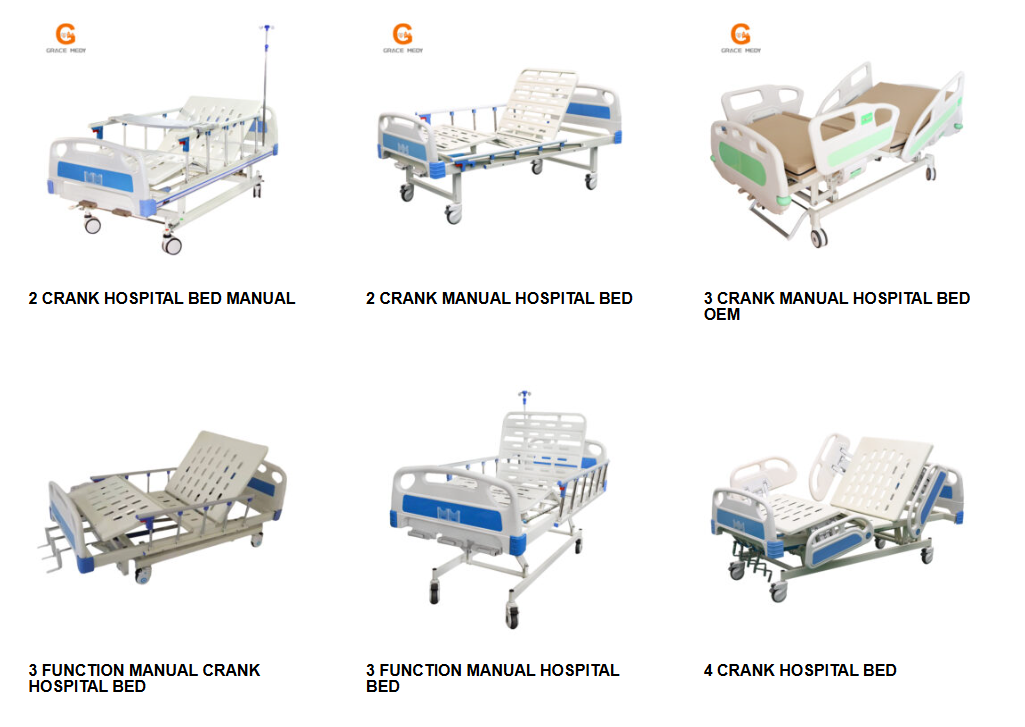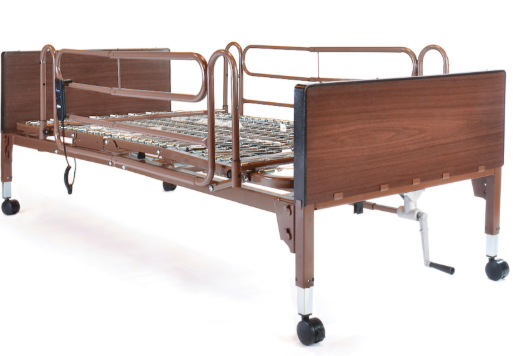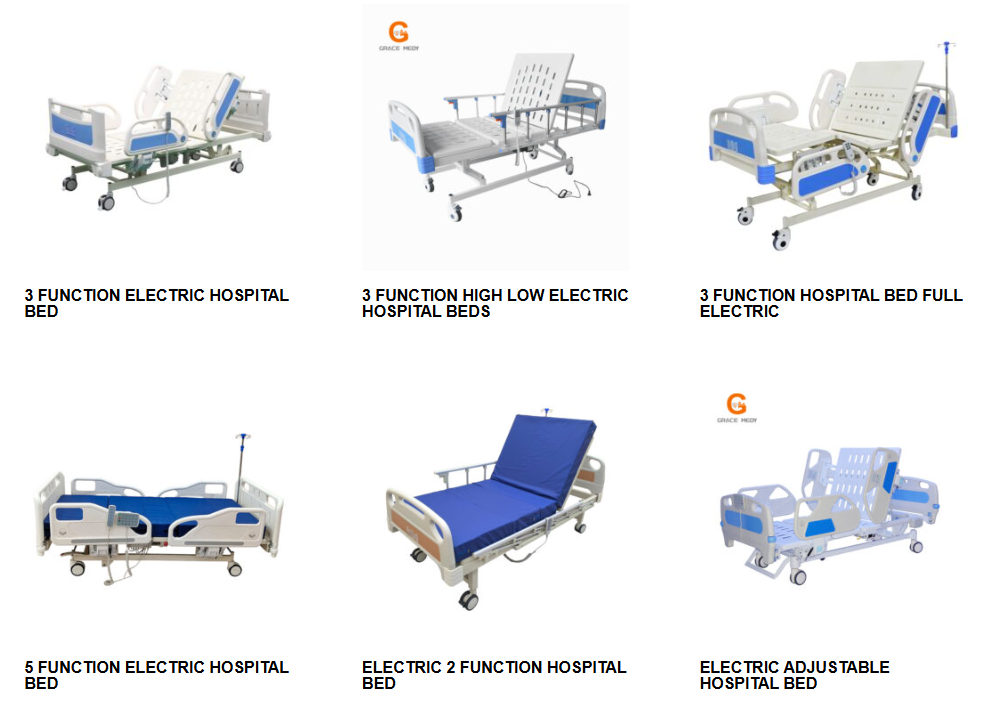Choosing the right medical bed is crucial for patient comfort and effective care recovery. Generally, hospital beds fall into three main categories based on their operating mechanism: Manual, Semi-Electric, and Full-Electric Medical beds. While manual beds imply cost-effectiveness and simplicity, electric options offer superior independence and ease for caregivers. Whether for a specialized hospital ward or a home care setting, understanding the differences in motors, adjustability, and load capacity helps you make the best decision. Below, we break down the specific features, pros, and cons of these three types.
Manual Medical Beds
Manual hospital beds adjust using hand cranks or levers. No power outlet is needed. These beds provide basic features for patient care. They focus on low cost, reliability, and easy adjustment. Here are their main benefits and specifications:

Key Features and Adjustability
Height Adjustment: You can raise or lower the bed. Common ranges go from 420 mm up to 680 mm.
Backrest and Footrest Angles:
The backrest adjusts from 0° to 80° (±5°).
The footrest adjusts from 0° to 40° (±5°).
Manual Operation: These beds use cranks for adjustments. You can adjust them during power outages. They work in places with unstable electricity.
Construction and Safety
Frame and Materials: Most manual beds use a powder-coated steel frame. This makes them durable. They combine ABS and PP plastics. These materials are clean and easy to wipe down.
Load Capacity: Models like the Grace Medy manual hospital bed support patients up to 250 kg.
Bed Dimensions: The patient surface ranges from 1930 × 830 mm to 2150 × 950 mm. Overall bed lengths measure between 2160 mm and 2280 mm.
Casters and Mobility: Beds have 360° swivel castors. These are often 5 inches in diameter. They include brakes for secure positioning.
Safety Railings: The beds include detachable or drop-down rails. Some use gas-spring assistance. These provide protection and easy access.
Standard Accessories: Each bed includes an IV pole and urine bag hooks. Optional features include shoe shelves or dinner tables.
Types and Use Cases
Model Types:
Two-function beds: You can adjust both bed height and backrest manually.
Three- and four-crank beds: These allow more adjustments. You can adjust the backrest and knee/foot section. This improves comfort. It supports specific medical needs.
Typical Environments: I recommend these beds for patients who need minimal repositioning. They work well in basic hospital wards, home care, or rehab settings.
Budget Consideration: Manual beds cost less than electric models. I suggest them for settings with limited resources. They also work as reliable backup during power failures.
Comparison Table: Manual Bed Features
|
Manual bed function |
Adjustment Range |
Typical Use Case |
|---|---|---|
|
Height |
420–680 mm |
Ease of movement, transfers |
|
Backrest |
0°–80° (±5°) |
Comfort, medical procedures |
|
Footrest |
0°–40° (±5°) |
Circulation, leg elevation |
|
Load bearing |
Up to 250 kg |
Adult and bariatric care |
Manual crank medical beds provide stable, safe patient support. They work well when electric features are not needed. Based on my experience, their durability and simple maintenance make them a top choice. They function anywhere. I like them for practical, budget-conscious medical settings.
Semi-Electric Medical Beds: Features, Benefits, and Comparison
I’ve worked with semi-electric hospital beds for years. They bring comfort to patients and make life easier for caregivers. These beds combine electric controls for the head and foot sections with a manual crank for height. This mix gives you modern features at a lower cost.

Key Features and Adjustability
Dual Adjustment System: A push-button remote raises or lowers the head and foot areas. Patients or caregivers get exact control. You adjust the overall height with a hand crank at the foot of the bed. This takes little effort, but it’s not hands-free.
Incline Ranges: The head section lifts up to 60–70 degrees. The knee/foot section goes up to 30 degrees. I find this makes it simple to find the right position for therapy or comfort.
Technical Specifications
Weight Capacity: Most semi-electric beds hold patients up to 350–450 lbs. The total load limit (with mattress and accessories) is also 450 lbs.
Dimensions: Bed lengths run from 80 to 88 inches. Widths are often 36 inches. You can set the height between 15 and 24 inches from floor to frame.
Bed Weight: Models start at 55 lbs for easy moving. Heavier models weigh up to 170 lbs. These offer better performance and stability.
Frame Materials: Manufacturers build frames from welded steel. Many add a zinc coating to stop rust. Headboards and footboards use high-impact plastics. These resist cracks and clean easily.
Representative Models and Price Points
Medline Semi-Electric Bed
Includes a 12″ foam mattress, four casters, battery backup, 450 lbs capacity, and electronic head/foot adjustment. Priced for buyers who want good value.
Drive Medical Ultra Light
Light design, 70° head section incline, 15″–24″ adjustable height, and simple setup. I recommend this for smaller budgets and home care.
Invacare Semi-Electric Bed
Built to last, with IP66-rated waterproof motors, 80″ x 36″ standard size, emergency manual crank, and high-impact end panels.
WhisperLite II
Five-part design, very quiet, supports up to 350 lbs (patient) or 450 lbs (total). Has 9V battery backup for safety.
Value and Suitability
I believe semi-electric hospital beds strike a smart balance. They cost less than full-electric models but offer more than manual beds. Based on my experience, they work great for home care, nursing homes, and medical facilities. You get patient comfort and ease of use without paying for full-height electric adjustment. I suggest these beds for most care settings where budget and core functions both matter.
Electric Medical Beds: Better Comfort and Safety for Patients
An electric hospital bed uses motors for all adjustments. It makes things easy for patients and caregivers. You control these beds with a hand-held remote. No manual cranks needed.

Key Features and Functions of Electric Medical Bed
Electric Adjustment: Press a button to raise or lower the head, foot, and bed height. Some beds lift the head up to 70°. They can lower to 4″ from the floor or rise to 30″.
Independence and Comfort: Patients with limited mobility can change positions by themselves. This improves their comfort and dignity each day.
Easier for Caregivers: All adjustments run on electricity. Caregivers and nurses don’t need to lift or crank anything by hand. This saves their energy and prevents strain.
Strong Construction: These beds have steel frames. They weigh around 160 pounds. Height adjusts from 16″ to 22″. Some models go lower or higher if you need them to.
Safety, Weight Capacity, and Power
High Weight Capacity: Standard electric medical beds support up to 450 pounds. Bariatric options handle 600 pounds or more.
Safety Features: These beds include side rails, bed exit alarms, lockable wheels, and battery backup. Some models have an emergency CPR release. The bed lowers to a safe level if power goes out.
Power and Backup: Most beds plug into a 220V wall outlet. Motors use 9V batteries for backup. This means essential adjustments work during power outages.
Leading Models and Practical Details
Grace Medy ICU Electric Medical Bed: 550 lb. capacity. Height adjusts from 16″ to 26″. Includes CPR function and double electric control(remote control and panel button control).
Dynarex Electric Homecare Bed: Height range 15.7″ to 22.8″. Easy to maintain. You can remove the motor while the patient stays in bed.
Solo Home Hospital Bed: Lowers to 4″ for safe entry and exit. Rises to 29″ for caregiver access. Has quiet auto-regression profiling.
Technical and Purchase Information
Warranty: Top models come with 3-year warranties. This gives you peace of mind.
Shipping: Boxes weigh from 74.5 to 109.5 lbs. Weight depends on the model and setup.
My Recommendations and Best Uses
I recommend electric hospital beds for hospitals, nursing homes, and home care. They work best where you need frequent and precise adjustments.
These beds suit patients who stay in bed most of the time. They help those who need repositioning often. They provide maximum safety and comfort.
Based on my experience, electric controls improve patient well-being. They make care tasks faster and safer for staff. The motors run quietly. You can customize many options. I believe these features make electric beds a strong choice for any care setting.
